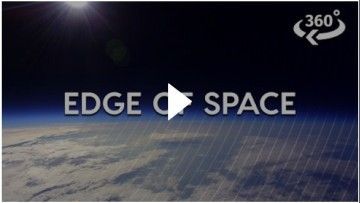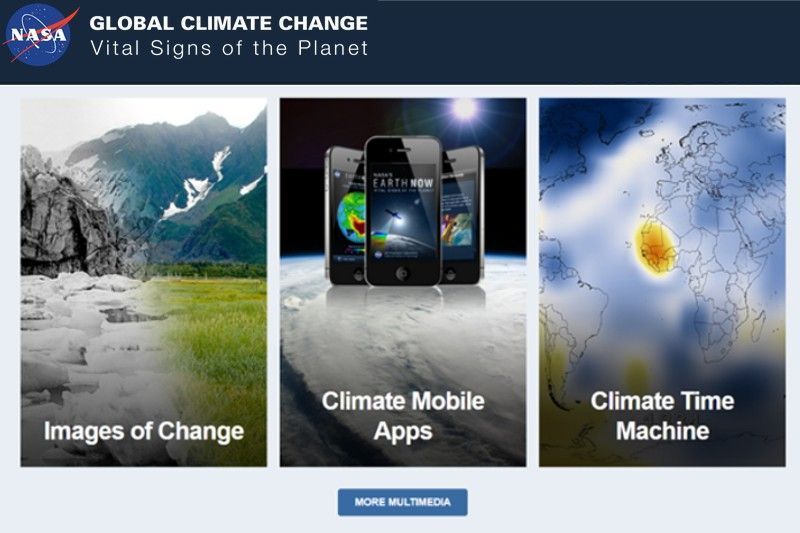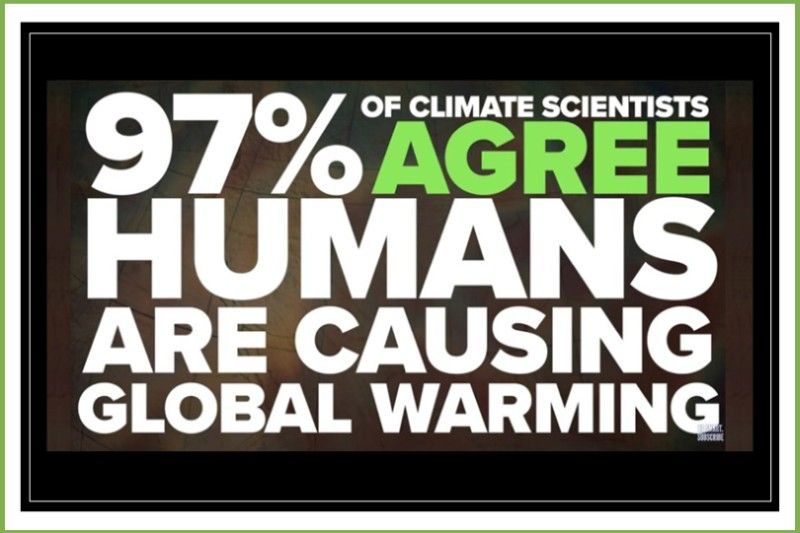Download NOAA and NASA climate activity worksheets with interactive tools, resources for satellites view real-time datasets in an immersive, 3D visualization for desktop, watch 360 videos of earth and space.
Global sea level rise is accelerating incrementally over time rather than increasing at a steady rate, as previously thought, according to a new study based on 25 years of NASA and European satellite data.
Interactive Features
Eyes on the Earth 3D
Fly alongside NASA satellites and view real-time datasets in an immersive, 3D visualization for your desktop.
Climate Time Machine
Go backward and forward in time with this interactive visualization that illustrates how the Earth's climate has changed in recent history.
Quizzes
Explore and test your knowledge with these interactive quizzes.
Multimedia
Explore a stunning gallery of before-and-after images of Earth from land and space that reveal our home planet in a state of flux.
Keep track of Earth's vital signs, see the planet in a state of flux and slow the pace of global warming with NASA's free mobile apps.
Travel through Earth's recent climate history and see how increasing carbon dioxide, global temperature and sea ice have changed over time.
Important note: Not all browsers support viewing 360-videos/images. YouTube supports uploading and playback of 360-degree videos/images on computers using Chrome, Firefox, Internet Explorer, and Opera browsers.
360-Video: The Call of Science
Join NASA Earth scientists for a 360-degree view of our planet as they head into the field to study ice in Greenland and coral reefs in Hawaii. You can stand with scientists on Arctic ice, fly above the ice sheet, glaciers and sea ice as part of Operation IceBridge, then head to Hawaii as scientists dive into Kaneohe Bay as part of NASA’s CORAL mission.

360-Video: Journey To The Edge Of Space
Experience what it’s like to leave Earth, traveling to over 90,000 feet into the stratosphere. Never before has a 360-video been recorded at these heights – so buckle up and enjoy the view as Seeker takes you on a journey to the Edge of Space.

Scientific Consensus: Earth's Climate is Warming
The 10 warmest years in the 139-year record all have occurred since 2005, with the five warmest years being the five most recent years. Credit: NASA's Earth Observatory.
Public Downloads
All items are free to view, share, and download.
Public Downloads - Español (Spanish)
When available, we provide all our content with a Spanish version in our public download section. You can find additional material from sources listed in all our articles.
Download GOES-R Series Satellite Climate Content
 A GOES-R Series Satellite Gets Launched Poster
A GOES-R Series Satellite Gets Launched Poster
 Fog and Low Clouds Poster BACK
Fog and Low Clouds Poster BACK
 Fog and Low Clouds Poster FRONT
Fog and Low Clouds Poster FRONT
 GOES Fun Activity Book
GOES Fun Activity Book
 GOES-R Board Game BACK
GOES-R Board Game BACK
 GOES-R Board Game Question Cards FRONT
GOES-R Board Game Question Cards FRONT
 GOES-R Comic Story
GOES-R Comic Story
 GOES-R Fun Activity Book
GOES-R Fun Activity Book
 GOES-R Series Bookmarks
GOES-R Series Bookmarks
 GOES-R Series Brochure
GOES-R Series Brochure
 GOES-R Stormy Space Weather Poster 11x17
GOES-R Stormy Space Weather Poster 11x17
 GOES-R Stormy Space Weather Poster 8.5x11
GOES-R Stormy Space Weather Poster 8.5x11
 Making a Weather Forecast with GOES-R Series Poster
Making a Weather Forecast with GOES-R Series Poster
 Meet the GOES-R Series Poster
Meet the GOES-R Series Poster
 SciJinks in a Snap Lightning Poster
SciJinks in a Snap Lightning Poster
 Why Don’t Satellites Fall Out of the Sky GOES-R Poster
Why Don’t Satellites Fall Out of the Sky GOES-R Poster
Download Climate Kids Content
 Climate Kids Flyer Coloring Sheet
Climate Kids Flyer Coloring Sheet
 Crossword Puzzle and Cloud Identification Quiz
Crossword Puzzle and Cloud Identification Quiz
 GOES Fun Activity Book
GOES Fun Activity Book
 GOES-R Board Game BACK
GOES-R Board Game BACK
 GOES-R Board Game Question Cards FRONT
GOES-R Board Game Question Cards FRONT
 GOES-R Fun Activity Book
GOES-R Fun Activity Book
 Grace activity and coloring pages
Grace activity and coloring pages
 The Displacifiers episode 1 Video
The Displacifiers episode 1 Video
 The Displacifiers episode 2 Video
The Displacifiers episode 2 Video
Download NASA Activities, Information and Resources
Playlist: Space Solar Power
The SSI Solar Power Satellites Research Collection
Solar Power Satellites. Space Based Solar Power. Beaming Energy From...
Solar Power Satellites. Space Based Solar Power. Beaming Energy From Space. The Official Research.
Space-based solar power: Scientists harvest and beam back solar energy from space • FRANCE 24
In the current climate and energy context, the search for sustainable...
In the current climate and energy context, the search for sustainable solutions has become a global issue. Recently, American scientists achieved a tech breakthrough: transmitting solar energy collected in orbit ...and beaming it back to Earth. This development could pave the way for a new era of continuous renewable energy production. Our Science Editor Julia Sieger tells us more.
Read more about this story in our article: https://f24.my/9e4i.y
🔔 Subscribe to France 24 now: https://f24.my/YTen
🔴 LIVE - Watch FRANCE 24 English 24/7 here: https://f24.my/YTliveEN
🌍 Read the latest International News and Top Stories: https://www.france24.com/en/
Like us on Facebook: https://f24.my/FBen
Follow us on Twitter: https://f24.my/TWen
Discover the news in pictures on Instagram: https://f24.my/IGen
Get the latest top stories on Telegram: https://f24.my/TGen
Groundbreaking research transmits energy from space to Earth
Earlier this year, scientists completed the first transmission of...
Earlier this year, scientists completed the first transmission of energy from space to earth, potentially revolutionizing carbon-free energy. The scientists behind the incredible achievement explain the process. Jeff Glor reports.
"CBS ...Saturday Morning" co-hosts Jeff Glor, Michelle Miller and Dana Jacobson deliver two hours of original reporting and breaking news, as well as profiles of leading figures in culture and the arts. Watch "CBS Saturday Morning" at 7 a.m. ET on CBS and 8 a.m. ET on the CBS News app.
Subscribe to "CBS Mornings" on YouTube: https://www.youtube.com/CBSMornings
Watch CBS News live: https://cbsn.ws/1PlLpZ7c
Download the CBS News app: https://cbsn.ws/1Xb1WC8
Follow "CBS Mornings" on Instagram: https://bit.ly/3A13OqA
Like "CBS Mornings" on Facebook: https://bit.ly/3tpOx00
Follow "CBS Mornings" on Twitter: https://bit.ly/38QQp8B
Subscribe to our newsletter: https://cbsn.ws/1RqHw7T
Try Paramount+ free: https://bit.ly/2OiW1kZ
For video licensing inquiries, contact:
How Wireless Energy From Space Could Power Everything | Ali Hajimiri | TED
Modern life runs on wireless technology. What if the energy powering...
Modern life runs on wireless technology. What if the energy powering our devices could also be transmitted without wires? Electrical engineer Ali Hajimiri explains the principles behind wireless energy transfer ...and shares his far-out vision for launching flexible solar panels into space in order to collect sunlight, convert it to electrical power and then beam it down to Earth. Learn how this technology could power everything -- and light up our world from space.
If you love watching TED Talks like this one, become a TED Member to support our mission of spreading ideas: https://ted.com/membership
Follow TED!
Twitter: https://twitter.com/TEDTalks
Instagram: https://www.instagram.com/ted
Facebook: https://facebook.com/TED
LinkedIn: https://www.linkedin.com/company/ted-conferences
TikTok: https://www.tiktok.com/@tedtoks
The TED Talks channel features talks, performances and original series from the world's leading thinkers and doers. Subscribe to our channel for videos on Technology, Entertainment and Design — plus science, business, global issues, the arts and more. Visit https://TED.com to get our entire library of TED Talks, transcripts, translations, personalized talk recommendations and more.
Watch more: https://go.ted.com/alihajimiri
https://youtu.be/RxrB7PDLJ18
TED's videos may be used for non-commercial purposes under a Creative Commons License, Attribution–Non Commercial–No Derivatives (or the CC BY – NC – ND 4.0 International) and in accordance with our TED Talks Usage Policy: https://www.ted.com/about/our-organization/our-policies-terms/ted-talks-usage-policy. For more information on using TED for commercial purposes (e.g. employee learning, in a film or online course), please submit a Media Request at https://media-requests.ted.com
#TED #TEDTalks #energy
Space Solar Power: The Future is Here . . . an NSS Space Forum with Gary Barnhard and John Mankins
Held March 23, 2023. The concept of Space Based Solar Power (SBSP) has...
Held March 23, 2023. The concept of Space Based Solar Power (SBSP) has been around for many years and NSS, with one of its primary goals being “Clean Energy from ...Space: Enabling Everyone to Benefit from Space Solar Power” has been and the forefront of promoting the concept. Programs are now ongoing in Japan, China, the UK and ESA, while research continues in South Korea, Australia and elsewhere. In the US, there is no program as yet, however NASA is assessing space solar power and research for military applications is underway at the Air Force Research Laboratory (AFRL).
With all of these new efforts to advance the concept, this is the perfect time for our space forum to take another look at SBSP. In this informative discussion with these two leading SBSP experts, you will learn what SBSP is, how it works, including how it differs from solar collection methods on the Earth’s surface and the advantages. You will hear about SBSP applications and the newest technologies. And Mr. Barnhard and Mr. Mankins conclude by laying out a path forward to deploying operational SBSP systems that truly demonstrate “The Future is Here . . .”
Gary Barnhard, a self-described synergistic technological philanthropist, entrepreneur, and serial venture capitalist now serving as the President & CEO of Xtraordinary Innovative Space Partnerships, Inc. (XISP-Inc), a start-up company focused on Cislunar technology mission development work as well as Barnhard Associates, LLC, a systems engineering consulting firm and Internet Service Provider (Xisp.net). His recent Technology Development, Demonstration, and Deployment mission development work includes Space Solar Power. He received a Bachelor of Science in Engineering from the University of Maryland College Park in 1982, combining Aerospace Engineering, Materials Science with graduate work in science policy, solar physics, and artificial intelligence/knowledge-based systems. Gary is an Associate Fellow of the AIAA, a National Space Society (NSS) life member, prior CEO, prior Executive Director, NSS Board of Director’s member, and NSS Director of Strategic Relationships.
John C. Mankins is an entrepreneur and internationally recognized leader in technology, systems innovation and management. He is the Founder and President of Mankins Space Technology, Inc. and Artemis Innovation Management Solutions LLC, a Director of Solar Space Technologies, Pty. Ltd. He also serves as Vice President of the Moon Village Association and as a Dean and Professor at Kepler Space University. He served as Chief Technologist for Human Exploration and Development of Space at NASA and a lead for NASA’s Lunar Outpost team in 2003, and he has been recognized as the leading expert in the field of space solar power. John’s 25-year career at NASA and the NASA Jet Propulsion Laboratory ranged from flight projects and space mission operations to systems-level innovation and R&D. Mankins holds undergraduate (HMC) and graduate (UCLA) degrees in Physics and an MBA in Public Policy Analysis (The Drucker School). John is a member of the NSS Board of Directors.
All you need to know about space based solar power
Try out my quantum mechanics course (and many others on math and...
Try out my quantum mechanics course (and many others on math and science) on Brilliant using the link https://brilliant.org/sabine. You can get started for free, and the first 200 will ...get 20% off the annual premium subscription.
This video comes with a quiz that will help you remember what we talked about: https://quizwithit.com/start_thequiz/1687730777328x298369257241124300
Solar power is a nice idea. Except for the issue with the clouds. And the nights. So, how about we instead put solar panels up in space and then beam the energy down? This futuristic idea is known as “Space Based Solar Power”. It’s been around since the 1960s, but in recent years several nations have launched projects to make it reality. I think they’re not kidding. Space-Based Solar Power is about to become a real thing. But how is it supposed to work? Is it a good idea to beam energy down from space? What are the pros and cons? That’s what we’ll talk about today.
💌 Support us on Donatebox ➜ https://donorbox.org/swtg
👉 Transcript and References on Patreon ➜ https://www.patreon.com/Sabine
📩 Sign up for my weekly science newsletter. It's free! ➜ https://sabinehossenfelder.com/newsletter/
🔗 Join this channel to get access to perks ➜
https://www.youtube.com/channel/UC1yNl2E66ZzKApQdRuTQ4tw/join
00:00 Intro
00:41 Who is working on it?
04:24 How does it work?
09:08 Pros
10:07 Cons
13:12 Summary
13:54 Learn More about Solar Power With Brilliant
#science #tech #quizwithit
Dear Earth: We're Sorry for What We've Done to You... — one-minute version 2022
The National Space Society presents the case for space solar power, the...
The National Space Society presents the case for space solar power, the future of clean, safe, limitless energy for everyone.
Space solar power will harness the power of the sun ...in orbit and beam energy where it is most needed on Earth, eventually replacing fossil fuels and allowing our planet to once again become the pristine home we deserve.
For more information and to donate to this cause: https://go.nss.org/ssp
Dear Earth: We're Sorry for What We've Done to You... — two-minute version 2022
The National Space Society presents the case for space solar power, the...
The National Space Society presents the case for space solar power, the future of clean, safe, limitless energy for everyone.
Space solar power will harness the power of the sun ...in orbit and beam energy where it is most needed on Earth, eventually replacing fossil fuels and allowing our planet to once again become the pristine home we deserve.
For more information and to donate to this cause: https://go.nss.org/ssp
Dear Earth: We're Sorry for What We've Done to You... — full version 2022
The National Space Society presents the case for space solar power, the...
The National Space Society presents the case for space solar power, the future of clean, safe, limitless energy for everyone.
Space solar power will harness the power of the sun ...in orbit and beam energy where it is most needed on Earth, eventually replacing fossil fuels and allowing our planet to once again become the pristine home we deserve.
For more information and to donate to this cause: https://go.nss.org/ssp
The Future of Solar Power
Solar power has been promised for decades as bringing us a bright...
Solar power has been promised for decades as bringing us a bright future, and at last is beginning to see widespread use. What new innovations and opportunities await Solar in ...the decade to come?
Sign up for a Curiosity Stream subscription and also get a free Nebula subscription (the streaming platform built by creators) here: https://curiositystream.com/isaacarthur
Join this channel to get access to perks:
https://www.youtube.com/channel/UCZFipeZtQM5CKUjx6grh54g/join
Visit our Website: http://www.isaacarthur.net
Join Nebula: https://go.nebula.tv/isaacarthur
Support us on Patreon: https://www.patreon.com/IsaacArthur
Support us on Subscribestar: https://www.subscribestar.com/isaac-arthur
Facebook Group: https://www.facebook.com/groups/1583992725237264/
Reddit: https://www.reddit.com/r/IsaacArthur/
Twitter: https://twitter.com/Isaac_A_Arthur on Twitter and RT our future content.
SFIA Discord Server: https://discord.gg/53GAShE
Credits:
Alien: Civilizations: Hibernating Aliens
Science & Futurism with Isaac Arthur
Episode 325, January 13, 2022
Written, Produced & Narrated by Isaac Arthur
Editors:
Keith Blockus
Sig’unnr
Yamagishi
Evan Schultheis
Cover Art:
Jakub Grygier https://www.artstation.com/jakub_grygier
Graphics:
Fishy Tree https://www.deviantart.com/fishytree/
Jeremy Jozwik https://www.artstation.com/zeuxis_of_losdiajana
Sergio Botero https://www.artstation.com/sboterod?fref=gc
Udo Schroeter
Music Courtesy of Epidemic Sound http://epidemicsound.com/creator
How space-based solar power can save the planet | FT
Space launch costs are dropping rapidly. Solar panels are cheaper than...
Space launch costs are dropping rapidly. Solar panels are cheaper than ever. Could space-based solar power soon be price-competitive with nuclear? Promoted as a zero-carbon solution, classified military space planes ...have also been conducting experiments into wireless power transmission. The FT's Peggy Hollinger looks at whether space-based solar power can move beyond science fiction.
#solarpower
See if you get the FT for free as a student (http://ft.com/schoolsarefree) or start a £1 trial: https://subs.ft.com/spa3_trial?segmentId=3d4ba81b-96bb-cef0-9ece-29efd6ef2132
► Check out our Community tab for more stories or to suggest videos.
► Listen to our podcasts: https://www.ft.com/podcasts
► Follow us on Instagram: https://www.instagram.com/financialtimes
How to Make Space Based Solar Power Model
Real like model of space based solar power plant. It is not a working...
Real like model of space based solar power plant. It is not a working model but a clear demonstration of SPS-Alpha.
Can you imagine, deploying solar panels in space, capturing ...and converting solar energy to electricity right from the space and send it back to earth wirelessly. interesting, right?
https://www.newphysicist.com/space-based-solar-power/
In space there's no atmosphere, its never cloudy and in geosynchronous orbit its never night. Yes, space is the perfect place for a solar power station to harvest uninterrupted power and can provide the earth with massive amounts of clean and renewable energy.
We know, On Earth solar power is greatly reduced by night, cloud cover, atmosphere and seasonality. That means its intermittent. The main drawback of solar power. Moreover, some 30 percent of of all incoming solar radiation never makes it to ground level. In space its always shining, the tilt of the earth doesn't prevent the collection of power and there is no atmosphere to reduce the intensity of sun's rays. How it would be, if we can harvest it?
The SSI Solar Power Satellites Research Collection
Solar Power Satellites. Space Based Solar Power. Beaming Energy From Space. The Official Research.





























